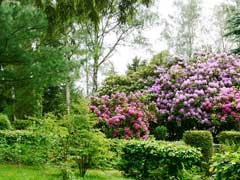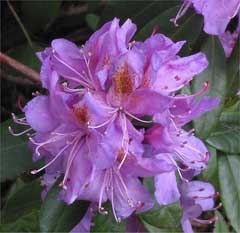 |
|
http://commons.wikimedia.org/wiki/User:AndreasPraefcke |
 |
| http://commons.wikimedia.org/wiki/User:Rasbak |
Translate this page:
Summary
Physical Characteristics

 Rhododendron ponticum is an evergreen Shrub growing to 5 m (16ft 5in).
Rhododendron ponticum is an evergreen Shrub growing to 5 m (16ft 5in).
See above for USDA hardiness. It is hardy to UK zone 7. It is in leaf all year, in flower from May to June. The species is hermaphrodite (has both male and female organs) and is pollinated by Insects.
Suitable for: light (sandy) and medium (loamy) soils and prefers well-drained soil. Suitable pH: mildly acid soils and can grow in very acid soils.
It can grow in semi-shade (light woodland). It prefers moist soil.
UK Hardiness Map
US Hardiness Map
Synonyms
R. lancifolium. R. speciosum.
Plant Habitats
Woodland Garden Dappled Shade; Shady Edge; Hedge;
Edible Uses
References More on Edible Uses
Medicinal Uses
Plants For A Future can not take any responsibility for any adverse effects from the use of plants. Always seek advice from a professional before using a plant medicinally.
Antirheumatic Cardiac
A medicine made from the plant is used to treat heart and circulation malfunctions, but it should not be used without expert supervision[9].
References More on Medicinal Uses
The Bookshop: Edible Plant Books
Our Latest books on Perennial Plants For Food Forests and Permaculture Gardens in paperback or digital formats.

Edible Tropical Plants
Food Forest Plants for Hotter Conditions: 250+ Plants For Tropical Food Forests & Permaculture Gardens.
More

Edible Temperate Plants
Plants for Your Food Forest: 500 Plants for Temperate Food Forests & Permaculture Gardens.
More

More Books
PFAF have eight books available in paperback and digital formats. Browse the shop for more information.
Shop Now
Other Uses
Hedge Hedge
Plants are being grown as a hedge at the RHS gardens in Wisley, Surrey[29]. It tolerates quite hard clipping[200].
Special Uses
Hedge Hedge
References More on Other Uses
Cultivation details
Succeeds in a most humus-rich lime-free soils except those of a dry arid nature or those that are heavy or clayey[1]. Prefers a peaty or well-drained sandy loam[1]. A pH between 4.5 and 5.5 is ideal[1]. Succeeds in sun or shade, the warmer the climate the more shade a plant requires[184, 200]. Hardy to about -15°c[184]. Plants are self-sowing aggressively in British woodlands and are often out-competing native trees by filling the understorey and preventing natural regeneration. They are considered to be a pernicious weed by many environmentalists. Succeeds in a woodland though, because of its surface-rooting habit[200], it does not compete well with surface-rooting trees[1]. Plants need to be kept well weeded, they dislike other plants growing over or into their root system, in particular they grow badly with ground cover plants, herbaceous plants and heathers[200]. Plants form a root ball and are very tolerant of being transplanted, even when quite large, so long as the root ball is kept intact[200]. Plants in this genus are notably susceptible to honey fungus[200].
References Carbon Farming Information and Carbon Sequestration Information
Temperature Converter
Type a value in the Celsius field to convert the value to Fahrenheit:
Fahrenheit:
The PFAF Bookshop
Plants For A Future have a number of books available in paperback and digital form. Book titles include Edible Plants, Edible Perennials, Edible Trees,Edible Shrubs, Woodland Gardening, and Temperate Food Forest Plants. Our new book is Food Forest Plants For Hotter Conditions (Tropical and Sub-Tropical).
Shop Now
Plant Propagation
Seed - best sown in a greenhouse as soon as it is ripe in the autumn and given artificial light. Alternatively sow the seed in a lightly shaded part of the warm greenhouse in late winter or in a cold greenhouse in April. Surface-sow the seed and do not allow the compost to become dry[200]. Pot up the seedlings when they are large enough to handle and grow on in a greenhouse for at least the first winter. Layering in late July. Takes 15 - 24 months[78]. Cuttings of half-ripe wood, August in a frame. Difficult[78].
Other Names
If available other names are mentioned here
Native Range
TEMPERATE ASIA: Lebanon, Turkey, Georgia, Russian Federation (Krasnodar) EUROPE: Bulgaria (southeast), Spain, Portugal
Weed Potential
Right plant wrong place. We are currently updating this section.
Please note that a plant may be invasive in one area but may not in your area so it's worth checking.
Conservation Status
IUCN Red List of Threatened Plants Status :

Growth: S = slow M = medium F = fast. Soil: L = light (sandy) M = medium H = heavy (clay). pH: A = acid N = neutral B = basic (alkaline). Shade: F = full shade S = semi-shade N = no shade. Moisture: D = dry M = Moist We = wet Wa = water.
Now available:
Food Forest Plants for Mediterranean Conditions
350+ Perennial Plants For Mediterranean and Drier Food Forests and Permaculture Gardens.
[Paperback and eBook]
This is the third in Plants For A Future's series of plant guides for food forests tailored to
specific climate zones. Following volumes on temperate and tropical ecosystems, this book focuses
on species suited to Mediterranean conditions—regions with hot, dry summers and cool, wet winters,
often facing the added challenge of climate change.
Read More
Expert comment
Author
L.
Botanical References
1117200
Links / References
For a list of references used on this page please go here
Readers comment